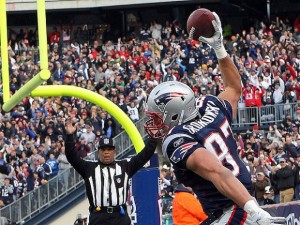The chaos continues in college football. In week 12, two more undefeated teams lost, with Ohio State losing at the last second to Michigan State, and Oklahoma State losing, 45-35, against Baylor. That leaves just two undefeated teams remaining in the Football Bowl Subdivision: Clemson and Iowa. The Tigers are now #3 in the SRS, mostly because both Oklahoma and Alabama have slightly higher margins of victory and strengths of schedule than Clemson.
Iowa is down at #15 in the SRS, mostly because of strength of schedule. the Hawkeyes played a terrible North Texas team and an FCS Illinois State out of conference, while Indiana, Minnesota, and Maryland aren’t doing much for Iowa’s schedule. On the top end, only three opponents — Wisconsin (#26), Pittsburgh (#28), and Northwestern (#47)– rank in the top sixty. Against that backdrop, Iowa’s margin of victory simply isn’t good enough to vault them into the top ten of the simple rating system. (For comparison’s sake, Baylor, North Carolina, and Navy have all faced weaker schedules, but have strong enough MOVs to rank ahead of Iowa.)
But this is mostly an academic discussion. For purposes of the 2015 season, Iowa remains in great position to make the playoff. The Hawkeyes have a sneaky tough matchup in the season finale, as Iowa travels to Lincoln, Nebraska to face a 5-6 Cornhuskers team that will be fighting for its own postseason berth. Yeah, Nebraska has six losses, but those games have come by a combined 23 points, and Nebraska has lost several of those games in the final seconds.
Three teams remain in complete control of their playoff destiny: Clemson, Alabama, and Iowa. If all the favorites win, that will leave the committee with a very interesting decision for the final spot, having to choose between Oklahoma and Notre Dame. And if Iowa loses, but Michigan State finishes 12-1, the Spartans may simply take Iowa’s spot, so that won’t help solve any Sooner/Irish debate. It’s still too early to panic for any of the contenders — I think we are only in the middle of the chaos — but the end of the regular season is shaping up to be very, very interesting.
Last week, I noted that the Big 12 would be fine, unless the winner of Bedlam lost on Saturday. And while Oklahoma did beat TCU, Oklahoma State suffered its first loss of the season, setting up a nightmare scenario for the Big 12. If the Cowboys beat the Sooners, the Big 12 may have Baylor as its only hope of making the playoffs.
And, for what it’s worth, Baylor is now up to #4 in the SRS. Below are the ratings through week 12:
[continue reading…]






